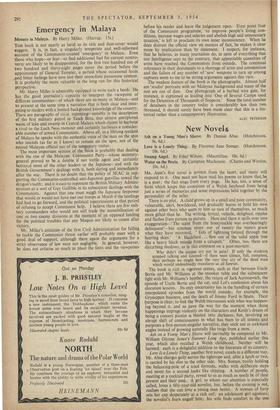Emergency in Malaya
Menace in Malaya. By Harry Miller. (Harrap. 15s.)
THE book is not nearly as lurid as its title and dust-cover would suggest. It is, in fact, a singularly temperate and well-informed account of the Communist-created 'emergency' in Malaya. Even those who hope—or fear—to find additional fuel for current contro- versy are likely to be disappointed, for the first two hundred out of two hundred and thirty-eight pages cover the period before the appointment of General Templer, a period whose occasional feuds And bitter feelings have now lost their immediate passionate content. It is probably the more valuable in the long run for this historical perspective. Mr. Harry Miller is admirably equipped to write such a book. He has the good journalist's capacity to interpret the viewpoint of different communities—of which there are so many in Malaya—and to present at the same time a narrative that is both clear and inter- esting to readers with a limited background knowledge of the country. There are paragraphs of vivid reporting—notably in the description of the first military patrol to Tasek Bera, that almost unexplored waste of lake and swamp in Central Malaya which claims to harbour a rival to the Loch Ness monster and certainly harb-ours a consider- able number of armed Communists. Above all, as a lifelong resident of Malaya he speaks with the authentic voice of the man on the spot who intends (as far as I know) to remain on the spot, not of the retired Malayan official nor of the temporary visitor.
The most important section of the book is probably that dealing with the rise of the Malayan Communist Party—whose secretary- general proved to be a double if not treble agent and certainly betrayed most of the other leaders to the Japanese—and with the British Government's dealings with it, both during and immediately after the war. There is no doubt that the policy of SEAC in sup- porting the Communist-controlled anti-Japanese guerillas sowed the dragon's teeth; and it is easy to represent the British Military Admini- stration as a sort of Guy Gullible in its subsequent dealings with the Communists. Against that one must weigh the Japanese firepower that would or would not have met our troops at Morib if the labdings had had to go forward, and the political repercussions at that period of refusing to accept Communist help. 1 believe there are few mili- tary commanders who would not still trade the immobilisation of one or two enemy divisions at the moment of an opposed landing for the political troubles that any Maquis are likely to create after victory. Mr. Miller's criticism of the first Civil Administration for failing to tackle the Communist threat earlier will probably meet with a good deal of support, although there again the arguments for a strict observance of law were not negligible. In general, however, he does not criticise so much as place the facts and the viewpoints before his reader and leave the judgement open. Even point four of the Communist programme, `to improve people's living con- ditions, increase wages and salaries and abolish high and unnecessary taxation,' is left to proclaim its own inner inconsistency. When he does distrust the official view on matters of fact, he makes it clear more by implication than by statement. I suspect, for instance, that he believes, as many journalists do, in spite of everything that our Intelligence says to the contrary, that appreciable quantities of arms have reached the Communists from outside. The continual references in their documents to a shortage of arms and ammunition and the failure of any number of `new' weapons to turn up among captures seem to me to be strong arguments against this view. The weakest feature of the book is the photographs. Almost half are 'studio' portraits with no Malayan background and many of the rest are out of date. One photograph of a barbed wire gate, for instance, is captioned as leading into 'One of Several Camps used for the Detention of Thousands of Suspects.' Since the total number of detainees in the country today is considerably less than two thousand, it should surely have been made clear that this is a his- torical rather than a contemporary illustration.
ALEC PETERSON


































 Previous page
Previous page